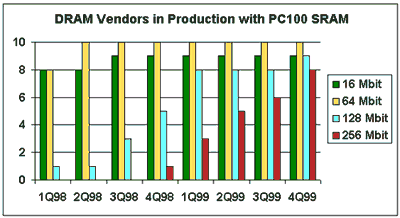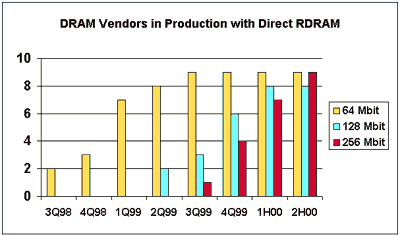|
|
 |
 |
|
|
 |
 |
 |
 |
Intel's goal is to ensure that memory subsystems continue to support evolving platform requirements through 1998 and beyond. Mainstream memory bandwidth requirements will be satisfied by EDO and 66-MHz SDRAM performance through the first half of 1998. Intel is working with memory vendors to keep up with the performance of faster processors and bus architectures. Intel has worked with leading DRAM vendors to anticipate this need by developing 100-MHz PC SDRAM Component and DIMM specifications. In the second half of 1998, the industry will see an adoption of 100-MHz SDRAM to complement new, faster Pentium® II processors. Beginning in 1999, the PC platform will be enhanced by Direct RDRAM to further enhance the interactive lifelike visual experiences on the standard PC platform, including workstation-quality 3D graphics and consumer-quality video.
|

|
 |
 |
 |
The emergence of 3D and video applications and the evolution of the PC platform to the Visual Connected PC keeps evolving the PC architecture. New PC designs that will be based on faster Pentium II processors in mid-'98 are driving the need for ever-higher system memory bandwidth. Intel's leadership and industry participation are delivering new memory technologies which enable the development of higher performance PCs.
|

|
 |
 |
 |
Continuous work on PC SDRAM specifications helps PC manufacturers showcase platform performance and meet development targets for cost, availability and high-performance features. By working with the industry to develop PC SDRAM and DIMM specifications, Intel is helping to assure that memory products are built to support the next generation of platform requirements. Industry-wide compatibility helps PC OEMs line up multiple compatible DRAM suppliers to meet their cost and availability targets, while providing a high-quality product to PC end users.
|

|
 |
 |
 |
Intel's goal is to ensure that memory subsystems continue to support evolving platform requirements and to assure that memory does not become a bottleneck to system performance. It is especially important to ensure that the PC memory roadmap evolves together with the performance roadmaps for the processors, I/O and graphics. To meet this goal, Intel has worked with leading DRAM vendors to develop the PC100 SDRAM Component and DIMM specifications that are now available on Intel's developer web site. In addition, Intel participates in ongoing industry dialog to assure that memory suppliers get their technical questions answered.
The diagram below summarizes PC100 SDRAM availability data we collected from 10 DRAM vendors. (Fujitsu, Hitachi, Hyundai, LG Semi, Micron, Mitsubishi, NEC, Samsung, TI, Toshiba). This shows that the industry is on track for the 66-MHz to 100-MHz SDRAM transition in the second half of this year.

Source: DRAM vendors—information not verified by Intel
Intel's role is to work with the memory industry to project future requirements, evaluate technology options, to help choose a path with adequate lead time and then to facilitate communication leading to a complete platform memory solution. This process achieved solid results beginning in 1994, with the introduction of PBSRAM technology for L2 cache. In 1994-1995, EDO DRAM was supported by the Intel 430FX PCIset to achieve major performance improvements on the Pentium processor. In 1996, the Intel 430VX PCIset supported 66-MHz EDO and SDRAM. Intel's newest chip set, the Intel 440LX AGPset, supports current platform requirements with 66-MHz SDRAM. Intel continues to support the memory industry with system-level simulation tools and design capability to ensure PC OEMs and users have the right products at the right time.
The next step in the memory roadmap is Direct RDRAM. Intel and Rambus are working together to extend Rambus technology to meet PC platform memory requirements for 1999 and beyond. At the last IDF, Intel and Rambus showed a technology demonstration using an Intel test chip. The demo focussed on showing the very clean signals running at 500-MHz (20% faster than the Direct RDRAM target speed to achieve
1.6-Gbyte/sec bandwidth!) in various trace configurations. During the presentation sessions Intel and Rambus architects explained how the fast data rates are achieved, and what system design considerations the PC motherboard designer has to be aware of.
Below is a summary of the Direct RDRAM availability data provided by the same 10 DRAM vendors as for the SDRAM data.

Source: DRAM vendors—information not verified by Intel
|

|
 |
 |
 |
Intel has delivered the PC SDRAM Component Specification, as well as the Serial Presence Detect and 100-MHz DIMM specifications to major vendors and OEMs. These specifications as well as 'Gerber' files were updated in February 1998, on the Intel developer web site. They provide all the information needed to develop memory modules to support the latest Intel platforms through 1998.
|

|
 |
 |
 |
Revisit this page often for the latest details on Intel platform support services and future information on Direct RDRAM.
|
 |
|
|
 |
 |
* Legal Information © 1998 Intel Corporation
|
|